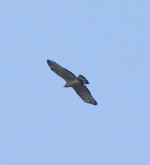Hi, I believe this photo, taken at about 10 am on Jan 30, 2020 in Southern Thailand, shows an Oriental Honey Buzzard. I am basing that on the tail pattern as well as the body and wing pattern, but primarily the tail pattern. I did note it has only 5 "fingers" but I am assuming that is because of the angle.
Am I correct or have I managed to wrongly id another bird ?
?
thank you in advance for taking the time to look at this.
steve
Am I correct or have I managed to wrongly id another bird
thank you in advance for taking the time to look at this.
steve






